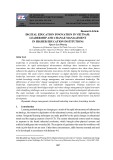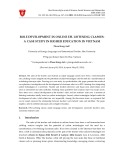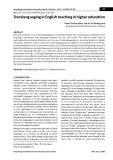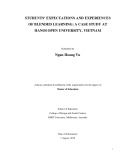
Tuyển tập Hội nghị Khoa học thường niên năm 2024. ISBN: 978-604-82-8175-5
547
WILLINGNESS TO COLLABORATIVE LEARNING AMONG
ENGLISH-MAJOR STUDENTS AT THUYLOI UNIVERSITY
Nguyen Van Son
Thuyloi University, email: nvson@tlu.edu.vn
1. INTRODUCTION & RESEARCH
BACKGROUND
Collaborative learning (CL) is a frequently
used method in higher education. It is a
pedagogical approach in which students have
chances to work together and towards a
shared goal. There are various approaches to
CL implemented including cooperative
learning, problem-centered instruction,
writing groups, peer teaching, discussion
groups and seminars, and learning
communities (Almajed, 2015). The research
has indicated that CL facilitates cognitive,
pro-social and emotional development
(Järvelä et al., 2010). It is defined as
“students actively contribute to the
attainment of a mutual learning goal and try
to share the effort to reach this goal”
(Janssen, 2014, pp. 4-5). CL brings about
many benefits to students such as
development of cognitive and social skills,
learning experiences shared, and positive
learning atmosphere (Almajed, 2015;
Weinberger & Shonfeld, 2020). However,
there are several issues to concerns such as
inappropriate behaviors, interactions,
motivation, personalities, experiences, time,
evaluation, and types of topics (Almajed,
2015; Weinberger & Shonfeld, 2020).
In the context of tertiary education, CL
even becomes a more important strategy
because it makes students more well-prepared
for jobs which requires teamwork skills
(Slotte et al., 2004). Therefore, understanding
students’ willingness to practice CL is
preponderant so that relevant stakeholders can
prepare their students for the future with
necessary skills in the 21st century. This study
aims to investigate the second-year English-
major students’ willingness towards CL at
Thuyloi University. Specifically, the research
answers the following questions: What are
advantages and disadvantages of CL, from
students’ perspective? What are their attitudes
towards CL? Are they skilled and willing to
practice CL?
2. RESEARCH METHODS
The quantitative approach was utilized in
this research and data collection method was
survey questionnaires. To be more specific,
the study adapted the Collaborative Learning
questionnaire developed by Weinberger and
Shonfeld (2020). There was one multiple -
choice question about experience in
collaborative learning (1 = not at all, 2 = in
some classes, 3 = most classes, 4 = all
classes). In the next 19 items, participants
were asked to reflect their ideas by selecting
one of the options from 1- Strongly disagree
to 5- Strongly agree on a Likert scale. The 19
items were about advantages of CL (6 items),
disadvantages of CL (6 items), attitudes
toward CL (5 items), CL skills (1 item), and
willingness to use CL (1 item).
109 second-year students whose major is
English language and linguistics at Thuyloi
University participated in the research. They
had almost finished their second year with
English language skills and some other
English as a medium of instruction (EMI)
subjects such as linguistics and research























